The post NEAR APAC Day One: Scaling Local Adoption, Regional Regulation, and AI in Web3 appeared first on NEAR Protocol.
]]>The day was charged with excitement, drawing over 8,000 attendees from various corners of the APAC region and beyond. With Web3 thought leaders, innovators, and enthusiasts converging in Vietnam, Day One of NEAR APAC kicked off with a slew of riveting discussions, industry insights, and speculations on the future of the Open Web with a focus on APAC.
From discussions around regional growth and investment potential to how AI and blockchain will transform the future of work, here’s everything that went down at an incredible start to NEAR APAC.
Setting the stage for NEAR APAC with Vietnam in focus
The event kicked off with a focus on southeast Asia, with NEAR’s Vietnam country director Riley Tran welcoming attendees and providing context as to Asia’s critical role in the overarching development and expansion of Web3. Tran was followed by two NEAR luminaries, CEO Marieke Flament and co-founder Illia Polosukhin.
“Asia’s young demographics and rapid digital growth, especially in Vietnam, position it as a leader in crypto and blockchain growth,” Riley explained. “With over 100 million new internet users in just three years, Asia’s momentum in Web3 is accelerating”
Marieke added that the overall NEAR ecosystem remains strong with over 29M active wallets and 650K daily active accounts. She added that a collaborative approach to building tomorrow’s Open Web is critical for tackling significant societal and digital challenges.
“Today’s Web 2.0 is closed and siloed, with the prevailing digital culture being a toxic dialectic,” Marieke expressed. “But the value loop of an Open Web holds immense promise. We’re already seeing how projects like KaiKai, SWEAT, and PlayEmber can move the needle in the right direction.”
Echoing Mariek’s sentiment, Illia emphasized that it’s not necessarily about championing a specific blockchain, but about creating a common layer and interface for the Open Web. This is precisely what the Blockchain Operating System (B.O.S.) is in the process of achieving.
“Looking forward, tech isn’t the only focus,” said Illia. “It’s about blending scalable solutions with user-centric experiences, with the B.O.S. becoming the essential entry point into Web3 for both users and developers.”
Asia’s role in mainstream adoption and regulatory hurdles
The push for mainstream blockchain adoption in APAC was also in focus on Day One, with NEAR Foundation CMO Jack Collier leading a panel discussion on current adoption challenges and how APAC can potentially lead the way in overcoming them.
“I’m extremely bullish on gaming as a key part of mass adoption,” opined Don Pham, Google Cloud’s regional Web3 specialist. “Vietnam is the birthplace of Axie Infinity, which is just the beginning of blockchain gaming’s potential. Use cases like loyalty, gaming, and music NFTs combined with better UX will likely be the path forward.”
The discussion dove deeper into the importance of user experience in the adoption of blockchain. Marieke reiterated that while technology forms the backbone, the real test will be simplifying the user journey, which can significantly hasten adoption across the APAC region as well as globally.
Regulation was also in focus with a panel about blockchain policies and APAC’s vision for governments and associations. Mary Beth Buchanan, a board member of the Cardano Foundation, drove home the need for regulatory clarity while discussing regional frameworks in countries like Hong Kong.
“The biggest challenge is not necessarily regulation, but lack of clarity,” observed Buchanan. “If regulations are unclear that will cause investors not to want to invest in the space. Builders become hesitant to build and users aren’t going to know what the rules are. Regulators need to recognize that clarity is what everyone wants.”
Spotlight on Artificial Intelligence during the afternoon sessions
Day One of NEAR APAC dedicated a significant chunk of its schedule to exploring the intricate interplay between AI and blockchain, particularly their role in APAC’s future technology and Web3 landscape. Illia took the stage just after the lunch break to discuss the Convergence of AI and Web3, diving deep into AI-empowered DAO and the future of AI-assisted work.
“While technologies like ChatGPT have found product market fit, much of AI is still siloed and doesn’t empower open source communities and projects,” Illia posited. “Web3 can operate in the middle, with AI models incorporating all participants and data sources. DAOs, for example, can be co-piloted by AI to achieve goals and KPIs faster and more efficiently.”
In the following panel discussion entitled “The Roles of Blockchains in an AI World,” Illia was joined by several AI and blockchain experts from the APAC region. One of the more distinguished panel members was Dr. Nguyen An Khuong, a lecturer and blockchain researcher from Ho Chi Minh University of Technology, who provided an academic perspective.
“We have a lot of research endeavors in Vietnam around ensuring AI’s ethical applications using blockchain,” commented Dr. Nguyen. “We’re looking at how transparency and accountability in AI decisions can be drastically improved with blockchain technology. Combining a neutral AI with a blockchain’s public ledger could enhance the ecosystem and foster wider adoption.”
Illia drove home that the potential “Skynet” scenario of AI taking over the world is mostly a projection of what humans might do if they were given supercomputing powers. In reality, developments like the B.O.S. and NEAR Tasks will aid humans in success and productivity, with AI agents acting as middlemen for assistance, sourcing, and even creativity.
Day One of the first-ever NEAR APAC was a rousing success, with these highlights just being the tip of the iceberg. The crowd was treated to bánh mì’s and Manga cosplay during lunch, B.O.S. building and gaming workshops on the Builder Stage, and an awe-inspiring NFT gallery from APAC creators.
As the sun sets in Saigon, the NEAR Foundation couldn’t be more appreciative of the Vietnamese crypto community. The momentum rolls on tomorrow with Day Two, so stay tuned for more updates and insights around emerging APAC trends in Web3, how blockchain gaming is taking off in Asia-Pacific, and local DeFi developments.
If Day One was any indication, the NEAR community’s growth, presence, and development in APAC will only continue accelerating through 2023 and beyond!
The post NEAR APAC Day One: Scaling Local Adoption, Regional Regulation, and AI in Web3 appeared first on NEAR Protocol.
]]>The post Case Study: Flipside Crypto on Building an Analytics Platform on the BOS appeared first on NEAR Protocol.
]]>In the latest NEAR Foundation Case Study video, we hear Flipside Crypto’s Evan “Captain” Owens and GJ Flannery. Not only is Flipside a team building innovative on-chain data and analytics solutions on NEAR, but they were one of the first ecosystem projects to build on the Blockchain Operating System (BOS).
In this case study video, GJ Flannery (Growth & Community) and Captain Owens (Strategic Partnerships) talk about the platform’s ecosystem of analytics and developers building widgets on the BOS with Flipside’s on-chain data. If you’re a founder or developer looking to hear directly from developers who’ve built on the BOS, then this Flipside Case Study video is not to be missed.
The post Case Study: Flipside Crypto on Building an Analytics Platform on the BOS appeared first on NEAR Protocol.
]]>The post Case Study: Building on the NEAR Blockchain Operating System (BOS) appeared first on NEAR Protocol.
]]>In the latest NEAR Foundation Case Study video, viewers take a deep dive into the Blockchain Operating System (BOS). We explore how the BOS, like a decentralized app store, isn’t controlled by any centralized entities. Other topics of conversation include BOS Gateways, the discoverability and composability of BOS apps and components, building on the BOS with Javascript, and integrations with Visual Studio Code and Github.
The post Case Study: Building on the NEAR Blockchain Operating System (BOS) appeared first on NEAR Protocol.
]]>The post Vistara Lands in the NEAR Ecosystem for Seamless Base Layer Roll-up Deployment appeared first on NEAR Protocol.
]]>Vistara stands out as a game-changing one-click rollup deployment framework that simplifies creating application-specific rollups across multiple blockchains. Streamlining the intricate rollup deployment process into a straightforward, single-click operation, Vistara will build a front-end on the BOS to make user-friendly, multi-chain rollup deployment a reality.
Simplifying multi-chain roll-ups with Vistara on the BOS
Existing frameworks such as Cosmos SDK and Substrate have sought to streamline certain software components in decentralized applications but often leave developers tied to one ecosystem that they must completely understand and master. Vistara will now present a unique solution by combining the BOS with backend chains like Ethereum and Celestia.
Vistara’s emphasis on simplifying rollup component creation aligns with NEAR’s vision of user-centric decentralization and a serverless Web3. With this new BOS front-end integration, developers in the NEAR ecosystem and beyond can now build and deploy rollups in one convenient location.
The result will be a user-friendly design that makes the deployment of a rollup as simple as selecting an option from a dropdown menu. The integration will also encourage a wider range of developers to build with rollups on the BOS with any chain, leading to a more diverse pool of innovations and robust growth.
Vistara’s integration not only simplifies the process but also expands the scope for innovation. It demystifies rollup creation, making it accessible to a broader range of developers. This inclusivity fuels a more diverse pool of applications, fostering growth and vibrancy within the NEAR ecosystem.
Vistara and BOS breaking base layer building barriers
Developing decentralized applications on base layers can be a complex process. Coordination of node operators, high costs, and extended development times are among the major challenges. However, Vistara is designed to confront these issues directly, streamlining the process and fostering efficiency.
Rollups — technologies that bundle or ‘roll up’ side-chain transactions into a single transaction — provide an effective solution. They help developers bypass the difficulties associated with building decentralized networks. Vistara leverages this rollup technology, pushing the NEAR ecosystem towards application-specific rollups.
The solution effectively untangles the complexities tied to base layer dependencies, forging a development environment on the BOS that stretches beyond traditional base layer confines. With Vistara, multi-chain developers can now bring their applications to life more swiftly and efficiently than ever before.
To sum up, Vistara’s user-friendly, multi-chain rollup deployment capabilities on the BOS will have a huge impact on the NEAR ecosystem and beyond. The integration will take much of the complexity out of rollup deployment for anyone, helping Web3 creators, builders, and developers bring their applications to life faster than ever.
The post Vistara Lands in the NEAR Ecosystem for Seamless Base Layer Roll-up Deployment appeared first on NEAR Protocol.
]]>The post NEAR at Collision: Start Your BOS Journey and Expand into the Open Web appeared first on NEAR Protocol.
]]>Don’t miss NEAR Horizon, NEAR Foundation’s new Web3 startup support platform, which will also be at Collision. If you’re a founder or developer, then you will definitely want to meet with the Horizon team to get started on the Web3 funding and building journey.
Here is what to expect from NEAR at Collision 2023.
NEAR Speaker Sessions you won’t want to miss
Tuesday, Jun 27, 12:00 – 12:45 PM
Location: Beanfield Centre, Masterclass 1
Masterclass: “The Fastest Way to Add Web3 to Your App”
NEAR is transforming Web3 for developers, enterprises, and users alike with the Blockchain Operating System (BOS) – a common layer for browsing and discovering open web experiences compatible with any blockchain. NEAR founder Illia Polosukhin shows how the fastest onboarding in Web3 combined with decentralized frontends and embedded social features can help Web2 brands and Web3 projects deliver new & easy experiences and grow their communities.
Speaker: Illia Polosukhin, NEAR Protocol, Co-founder
Tuesday, Jun 27, 2:10 – 2:35 PM
Location: Enercare Centre, MoneyConf
Fireside Chat: “At the intersection of AI and Web3”
Speakers:
- lllia Polosukhin, Near Protocol, Co-founder
- Elad Gil, Investor
Moderator: Lucinda Shen, Axios, Fintech Reporter
Wednesday, Jun 28, 01:30 – 02:15 PM
Location: Beanfield Centre, Masterclass 4
Masterclass: “How to Decentralize Any Frontend Using BOS”
Learn how to store your frontend codebase entirely on-chain and make it more accessible to users with NEAR’s Blockchain Operating System (BOS).
Speaker: Miao Jiang, Head of Product, Proximity Labs
Wednesday, Jun 28, 02:30 – 03:15 PM
Location: Beanfield Centre, Masterclass 4
Panel: “Charting the Course for a Thriving Web3 Ecosystem”
Delve into the current state of web3 investing, identify the crucial elements for building a thriving web3 ecosystem, and explore innovative strategies for scaling startup support platforms.
Speakers:
- Joyce Yang, Founder, Global Coin Research
- Steven Chien, Founder, Press Start Capital
- Paul Hsu, Co-founder, Decasonic
- Moderator: Laura Cunningham, General Manager, NEAR Foundation
Thursday, Jun 29, 12:23 – 12:27 PM
Location: Enercare Centre, Growth Summit
Keynote: “Solving the Blockchain Enterprise Dilemma”
Speaker: Sandi Fatic, Co-founder, CEO, Calimero Network
Events from the NEAR Community
June 27, 6-9 PM – NEAR Horizon Pitch & Networking | Collision 2023
The NEAR Horizon team is partnering with VCs and Funding Teams from around the world who are looking to back exceptional entrepreneurs for the long term to build the future of Web3.
June 28, 10 AM-8 PM – Web3 Day (& Night) | Collision Conference Toronto
An invite-only event for the Web3 community & Web3 curious during the Collision conference in Toronto. Panels, speakers, networking, art, music, food & drinks, pitch opportunities, and more.
June 29, 6-9 PM – NEAR Toronto Launch Party
An exhilarating event that marks the launch of the NEAR Toronto Regional Community and concludes the three-day Collision Conference.
Stay tuned to Near.org/collision for the latest event updates.
The post NEAR at Collision: Start Your BOS Journey and Expand into the Open Web appeared first on NEAR Protocol.
]]>The post Case Study: Pagoda Chief Product Officer Alex Chiocchi on the BOS appeared first on NEAR Protocol.
]]>To showcase some of the innovative products launching on NEAR, the Case Studies content vertical is making a return. With its new multimedia makeover, Case Studies will demonstrate how these projects are leveraging the power of NEAR’s layer 1 protocol and the Blockchain Operating System (BOS) to distribute their apps and onboard the masses into the open web.
The new NEAR Case Studies series kicks off with a video featuring Pagoda’s Chief Product Officer Alex Chiocchi. For much of the last year Alex has been deeply embedded in the development and launch of the BOS — an OS for an Open Web.
In the BOS Case Study video, Alex explains how the BOS takes advantage of the NEAR Protocol’s scaling architecture, while allowing builders to code in languages they already know, like Javascript. As you’ll learn from Alex, the BOS makes it easy to use the tools you already know to build apps that engage users, while fostering an open web free from centralized platforms.
Stay tuned for more Case Study videos on NEAR, the Blockchain Operating System for an open web.
The post Case Study: Pagoda Chief Product Officer Alex Chiocchi on the BOS appeared first on NEAR Protocol.
]]>The post Get to Know the BOS: FastAuth for Easy, Web2 Style Onboarding and Account Recovery appeared first on NEAR Protocol.
]]>With FastAuth, BOS users get a better than Web2-style onboarding experience, allowing them to easily create an account for any app on the BOS without a new password or the need to buy any crypto. And perhaps most powerfully for developers, FastAuth is both the easiest and fastest way to get people to try their new components and apps, yet another reason why developers will want to build on the BOS. This helps dramatically lower the threshold for adoption and opens the door to bringing billions of Web2 users into the Web3 space.
To get up to speed on FastAuth, here is a FastAuth primer with some product demo videos.
Easy onboarding and email recovery with FastAuth
FastAuth gives users the power to quickly and easily create a single account that can be used for any website or app that integrates with the Blockchain Operating System (BOS). This feature makes FastAuth an ideal tool for developers building components on NEAR.
With a Web2-style onboarding experience that puts the user experience front and center, users can create a free account using biometrics, phone prompts, and an email address. This means that users can quickly interact with an app but also easily re-authenticate to the app using the same or different devices.
Since most users are accustomed to centralized authentication methods like “Sign in with Google”, Web3 account management using seed phrases and wallets have, until now, created a significant barrier to entry for many people. By combining FastAuth with decentralized email recovery, users no longer need to remember seed phrases or install third party wallet applications. Users can recover their accounts through a “Single Sign-on” (SSO) process with the email they used at registration.
Account recovery is also decentralized and does not give custodial access to full access keys to any single custodian. It is accomplished through a process called “multi-party computation”. This finally paves a way for mass adoption with an easy, secure, and decentralized account recovery system.
With FastAuth, one of the most challenging parts in onboarding users to Web3 no longer exists. Now, users can set up a BOS account quicker than creating a Gmail, Facebook, Tiktok, or Instagram account. And developers can deliver their Web3 components, apps, and experiences more seamlessly than ever.
No third-party applications required
FastAuth also removes the need to download any third-party applications. Everything just works seamlessly right from the browser on your desktop or mobile device.
By creating an easy, user-centric experience, FastAuth makes the open web accessible to everyone right from the get-go and opens the door to mainstream adoption. Anyone developing components on the BOS can leverage this user-friendly experience to quickly and intuitively get their apps in front of users.
Create an account without crypto
BOS FastAuth has another great trick up its sleeve. Until now, getting started in Web3 and interacting with apps meant acquiring crypto first.
With FastAuth, new users can get started right away without having to buy or be gifted crypto. This is a game changer for developers, enterprises, and end-users alike. Through FastAuth’s use of NEAR’s Meta Transactions and Zero Balance Accounts, users can register an account free of charge. Developers can also use this to their advantage as Meta Transactions paired with relayers, which allow them to sponsor initial interactions for new users without needing to purchase $NEAR.
This streamlined onboarding experience allows developers to significantly increase conversion rates for people trying their components and apps for the first time. FastAuth also expands an app and website’s audience by making it more accessible to mainstream users.
FastAuth creates an easy way for enterprises to integrate Web3 and crypto technology into their business. With just a few lines of code, they can onboard existing users into powerful new community and commerce experiences that are accessible, highly secure , and decentralized.
End users can also get started using Web3 apps and experiences in an easy, accessible way. Setting up a secure fully user-owned account now only takes seconds.
What’s next for FastAuth
While FastAuth is already enabling fast and simple onboarding of mainstream users as well as streamlining component-building for developers on the BOS, a number of other features and upgrades are already in the works:
- The ability to extend relayers and FastAuth to additional gateways beyond near.org
- Further MPC decentralization
- Multi-chain compatibility
- Two-factor authentication
Stay tuned to near.org for new FastAuth features and upgrades, as they are rolled out.
The post Get to Know the BOS: FastAuth for Easy, Web2 Style Onboarding and Account Recovery appeared first on NEAR Protocol.
]]>The post NEAR at Consensus Highlights appeared first on NEAR Protocol.
]]>Let’s take a look at everything NEAR at Consensus, including the BOS, NEAR Horizon, a submissions call for the latest edition of Women in Web3, and much more! And stay tuned for more NEAR at Consensus highlights over the next few days.
The BOS is now live on Near.org
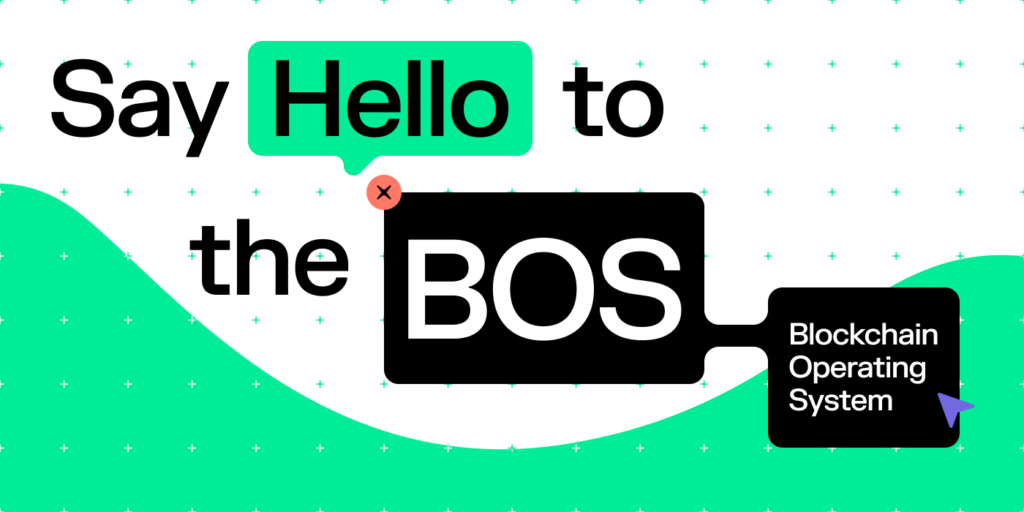
On April 26th at Consensus, NEAR co-founder and Pagoda CEO Illia Polosukhin and Pagoda Chief Product Officer Alex Chiocchi announced that the Blockchain Operating System (BOS) — a real alternative to the Operating Systems of centralized platforms — is now live at near.org.
As a blockchain operating system for an open web, the BOS is accessible to everyone, not just web3 natives. And it makes Web3 and Web2 easier than ever to access and navigate for users and developers alike. With the BOS, you no longer have to choose between decentralization and discoverability. Devs and users get the best of both worlds, whether they are new to Web3 experiences and want to play around, or developers looking to build an open web.
Read the full BOS announcement here.
NEAR Horizon: A revolutionary accelerator for Web3 startups
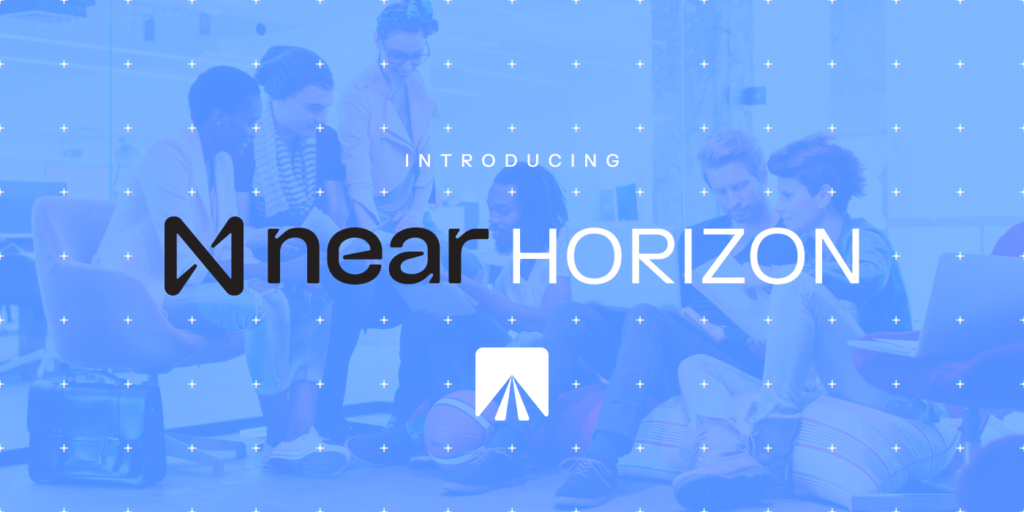
NEAR Foundation also announced the launch of Near Horizon, a Web3 accelerator program, on the 26th from Consensus. Built on the Blockchain Operating System (BOS), Horizon features a revolutionary marketplace where Web3 startups can find the support they need for building on Near and cross-chain platforms.
Together with partners Dragonfly, Pantera, Decasonc, Blockchange, Fabric Ventures, dLab, Hashed, and Factomind, and Outlier Ventures, Near Horizon is on a mission to empower founding teams with the tools and support they require to accelerate the development of sustainable, profitable, innovative startups on Near.
Near Horizon’s robust network of support is a game-changer for Near builders, offering new opportunities and resources to propel the best minds in the Near ecosystem to success.
Read the full NEAR Horizon announcement here.
NEAR opens submissions for Women in Web3 Changemakers 2023
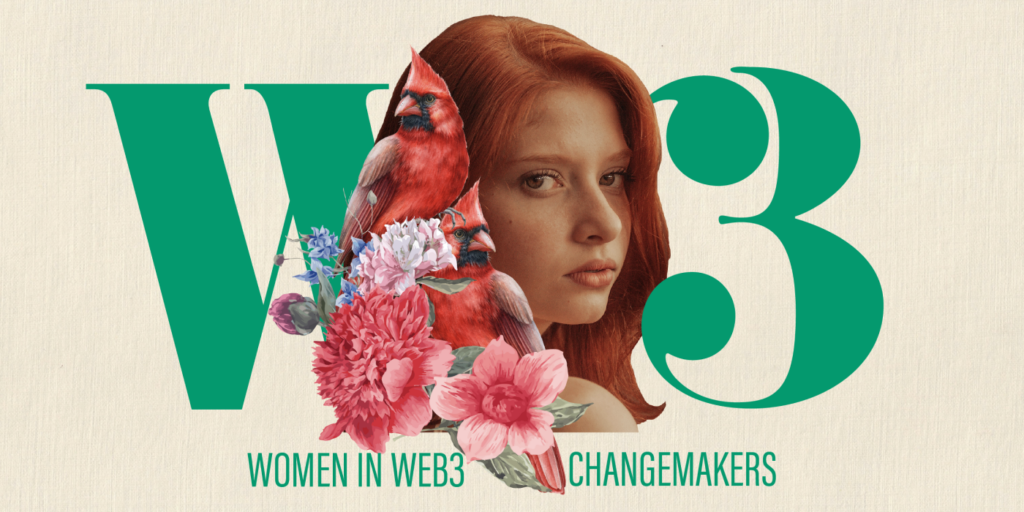
Following its hugely successful launch a year ago, Women in Web3 is back! On Day 2 of Consensus, NEAR Foundation announced the return of its global Women in Web3 Changemakers list.
Nominations are now open for 2023! Designed to showcase the talented and socially mindful women who make up the Web3 ecosystem, the initiative will once again spotlight ten exceptional leaders across the international sector and the amazing, sustainable work they do.
Members of the Web3 community — both men and women — are welcome to nominate and submit the names of female colleagues who they feel should be recognized for their exemplary contribution to Web3. Women who work in Web3 can also nominate themselves.
Each nominee should meet the following criteria, which NEAR uses to define impact:
- Inclusion – driving ideas that are good for society, sustainable, and socially impactful.
- Influence – in the community and among peers.
- Innovation – contributing to interesting and socially impactful projects at work or independently.
The top ten Changemakers will be decided by you — the community!
Important Dates for Submissions and Voting
More details on the voting process will be announced shortly. But here are some important dates.
- June 1, 2023 — Nominations Deadline
- June 5, 2023 — Voting Begins
- June 19, 2023 (Midnight) — Voting Ends
- June 29, 2023 — 10 Changemakers for 2023 will be announced
Those selected will be included in the Women in Web3 Changemakers list, which will be shared with the press and the global community. NEAR will also feature the winners in a special series of video interviews that will air across NEAR’s social platforms and distribution network to share each award-winner’s story and contributions to Web3. Founders of Web3 companies that have made the list will also have the opportunity to meet with investors and pitch for funding at the event.
Google Cloud Unveils Web3 Startup Program
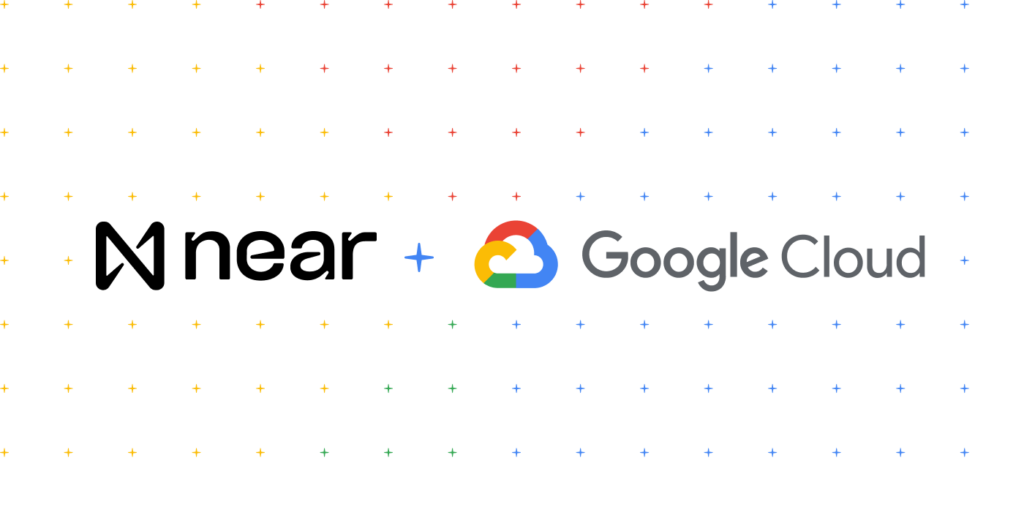
Google Cloud recently made a splash in the Web3 space by announcing its Web3 Startup program via a Twitter thread during Consensus. Catering to seed and Series A projects and startups, the program offers up to $200K in cloud credits, and access to technical training. Recipients also receive partner perks including discounts on Nansen AI products and platform credits from Alchemy, and Thirdweb’s gasless contract deployment, support, and co-marketing opportunities.
Google’s support of Web3 will benefit founders building on the Blockchain Operating System (BOS) and those partnering with the recently launched NEAR Horizon, an accelerator revolutionizing how founders are supported in Web3. NEAR Horizon will enable founding teams to scale their project with the support they need, increasing the number of founding teams building great products with real-world value on the NEAR Protocol.
To apply, visit the application portal and explore more information on the official website.
Here’s how to get involved:
- Founders: Join NEAR Horizon here
- Accelerator Programmes: Register your interest in a partnership here
- Backers: Register your interest in partnering here
NEARCON is Returning to Lisbon and NEAR APAC is Headed to HCMC, Vietnam!
Today at Consensus, NEAR Foundation announced that NEARCON will take place in Lisbon, Portugal on November 7 – 10, 2023. In an effort to globally scale and create more accessible events, the NEAR Foundation also announced that NEAR APAC will take place in Ho Chi Minh City, Vietnam on September 8 – 12, 2023. Both events will gather an audience of builders, Web2 and Web3 entrepreneurs, industry professionals, investors, and creators from all over the world.
NEAR APAC will be the NEAR Ecosystem’s first and largest event in the APAC region. NEAR APAC delivers a world-class lineup of speakers to share latest APAC developments, unlimited potential of the blockchain industry, regional market insights, Web3 hacker festival, and insightful events for networking opportunities with local communities and partners. Head to https://nearapac.org/ on May 15th to secure your NEAR APAC tickets!
NEARCON, the NEAR Ecosystem’s Annual flagship conference is headed back to Lisbon. The Mainnet anniversary of the protocol’s launch and the biggest announcements from the Ecosystem will be featured at NEARCON. Hear from some of the most iconic names in Web3 speak on Technical updates, Web2 and Web3 trends, the latest on Governance and Regulation, Arts and Culture, and much more.
This year the conference will take over two venues: Convento De Beato and Armazem Lisboa. Convento de Beato will host the core conference and will feature two larger stages whereas Armazem Lisboa will be Developers HQ where hackers will build all day. Both venues are just a 10 minute walk from each other. Mark your calendars because on June 1st NEARCON tickets will go live on nearcon.org!
See you in HCMC and Lisbon this Fall!
Updates from around the NEAR Ecosystem
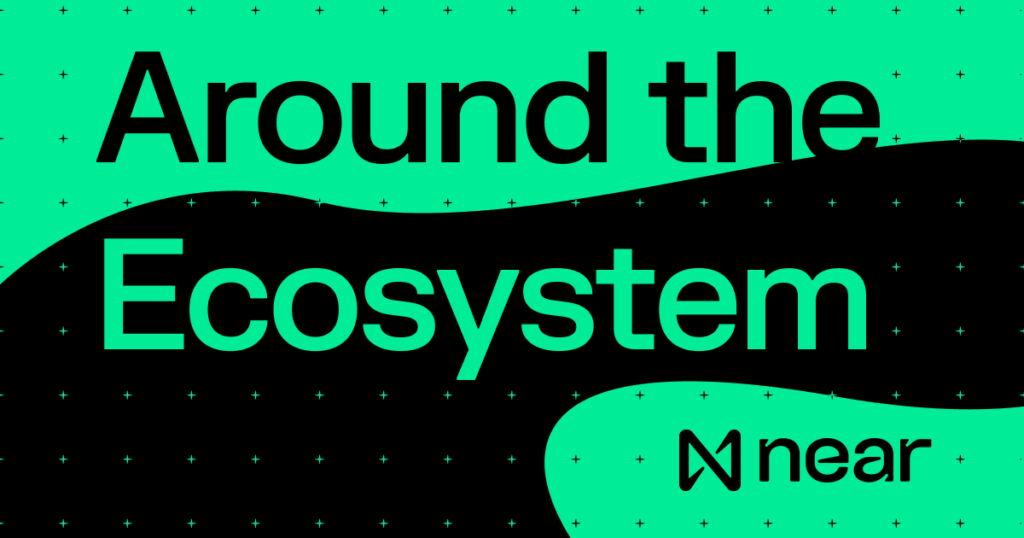
Mailchain brings encrypted communication to NEAR-based dApps
Mailchain, an open source, multi-chain communication layer for Web3, announced integration with NEAR. Now, NEAR developers can send encrypted messages between blockchain wallet addresses with simple, unified inbox to view and send messages and keep track of on-chain activity.
NEAR’s vision has always been to onboard the next billion users to the Open Web. With Mailchain, these next billion users can communicate natively with one another, regardless of blockchain.
Mailchain’s integration with NEAR is a significant step towards strengthening the interoperability mission of NEAR’s blockchain operating system (BOS). NEAR’s BOS and Mailchain are both chain-agnostic, prioritize usability and security, and together make Web3 more accessible and interoperable for users.
“Our vision aligns perfectly with NEAR’s–to onboard the next billion users,” said Tim Boeckmann, CEO of Mailchain. “When building Mailchain, we knew these next billion users would want to communicate with what mattered most to them, their blockchain identities. Mailchain’s secure communication protocol makes this a reality. We believe that this integration is a big step forwards for the developers who are building the next generation of the Internet.”
XP Network brings cross-chain NFT bridge to NEAR
During Consensus, the XP Network, a cross chain NFT bridge, went live on NEAR mainnet. XP Network allows NFT holders to transfer their NFTs to any other supported chain. XP Network recently showcased their cross-chain NFT bridge by transferring a BSC NFT over to Near via the XP Network bridge, and selling it on Mintbase.
Now, NFT marketplaces built on NEAR Protocol like Paras, Berry Club, Mintbase, Flux, Few & Far can list the most promising NFT collections from almost 30 other chains. XP Network’s integration will supercharge both arts and collectibles, as well as Web3 gaming on NEAR, with players now being able to buy and trade NFTs in-game across chains.
kuutamo and Lattitude.sh give NEAR validators access to premium infrastructure
From Consensus, Kuutamo announced its partnership with enterprise-grade infrastructure provider Lattitude.sh, which will give developers and current NEAR validators more flexibility and control. NEAR validators using both kuutamo and Latitude can now access premium infrastructure at a limited promotional price, or apply for the kuutamo x Latitude Program.
A venture-backed technology company, Kuutamo offers a resilient and user-friendly node infrastructure, designed for the peer-to-peer economy. kuutamo launched the world’s first high availability node for the NEAR Protocol, giving users full control and flexibility (no lock-in effect) to execute their desired cloud strategies — differentiating itself from most large public cloud providers in the process.
Latitude is an emerging global leader, offering access to enterprise-grade infrastructure in the world’s most advanced data centers. In its partnership with kuutamo, Latitude is expanding its offering to developers and NEAR validators. Latitude already supports other leading blockchains and Web3 companies such as Solana, Ankr, and Riot Games.
WOMBI brings Web2-style analytics to NEAR
During Consensus, Wombi — a Web3 attribution platform — announced that it is now live on NEAR. With an aim to be the Google Analytics of Web3, Wombi helps decentralized app developers by connecting Web2 and Web3 funnels, so they can instantly see which marketing channels are bringing them the most impactful users.
Wombi is now publicly available to all dApps fully live or building on the NEAR Blockchain Operating System or Protocol. All developers get free product and marketing analytics, making NEAR the first Layer 1 with a live attribution product.
The post NEAR at Consensus Highlights appeared first on NEAR Protocol.
]]>The post NEAR Blockchain Operating System is Now Live on Near.org appeared first on NEAR Protocol.
]]>A real alternative to the Operating Systems of centralized platforms, the BOS is now live at near.org. As a blockchain operating system for an open web, the BOS is accessible to everyone, not just web3 natives. And it makes Web3 and Web2 easier than ever to access and navigate for users and developers alike.
With the BOS, you no longer have to choose between decentralization and discoverability. Devs and users get the best of both worlds, whether they are new to Web3 experiences and want to play around, or developers looking to build an open web.
Seamless Web2 style onboarding for Web3
When entering Web3, users want an easy Web2-style onboarding experience. Until the BOS, this just wasn’t possible.
With FastAuth, BOS users get to experience a simple and seamless Web2 style onboarding. Users can get started quickly by creating an account for any app on the BOS — without the need for crypto.
By putting the user experience at the center, FastAuth creates a familiar style of onboarding experience, in which users can create a free account with biometrics, phone prompts, and an email address. Users can now quickly interact with an app without having to remember long seed phrases and other difficult passwords.
This will help dramatically move Web2 users into the Web3 space with ease.
Developers are empowered to start and build quickly
The BOS isn’t just built for Web3 natives. It’s designed for any developer interested in open-source and decentralization.
To make Web3 app development fast and easy, the BOS offers a comprehensive set of tools and capabilities to get developers started quickly. These developer enablement tools and capabilities make it possible for developers to quickly build composable apps for the open web, as well as build complete projects using current workflows, seamlessly onboard users, get feedback from real users, and increase discoverability.
From Day 1, any developer can start building on the BOS, making Web3 a more accessible space for all.
Making Web3 search as intuitive as Web2
Finding things in Web3 isn’t always easy. While decentralization is a core attraction to Web3, this very same benefit can make it hard to discover everything that Web3 has to offer.
The NEAR Blockchain Operating System fixes this problem with a comprehensive search experience. On the BOS, users can now quickly find all of the apps and components for building on Web3, as well as connect to people and communities.
BOS users can quickly discover apps, components, and reference documents with an integrated search bar, filtering, and sorting panels. Comprehensive search and discovery also benefits developers, entrepreneurs, and projects across the BOS by exposing their work to a large audience.
Add and maintain new app experiences with BOS gateways
The BOS also features gateways — access points to Web3 apps that pull front-end code directly from the NEAR blockchain and render it for their users.
Gateways assume a variety of forms, from wallets and portfolio management tools to popular single-use applications — like, SWEAT — that want to add additional functionality. Gateways help with simple tasks, like adding swap functionality, all the way up to creating decentralized app stores, and much more. This functionality is available by simply adding a JS library, then choosing which app front-ends you want to include.
Typically in Web3, developers spend a lot of time building and getting their apps discovered. During this process, users often need to switch between multiple platforms to discover apps and experiences. Gateways help to overcome this by making it possible to meet users where they already are, while giving them a broader range of apps and experiences.
Govern your Web3 experience with a content moderation framework
Traditional content moderation processes — seen most notably in Web2 social network apps— are centralized and often lack transparency, making them ill-equipped to meet the demands of content that is potentially offensive, risky, or illegal. With the growing influence of Web3 platforms the need for an innovative solution that addresses these challenges is more critical than ever.
The BOS features a scalable, open source content moderation system. With these BOS features, users can govern their own online experience.
The moderation framework leverages the power of the BOS to tackle the many challenges of managing User Generated Content (UGC) through community engagement and automation, providing a scalable, transparent solution to content review that is easy to use and legally compliant.
With a decentralized approach and community-driven governance and moderation, the BOS’s moderation framework is poised to redefine content moderation for Web3 platforms and contribute significantly to a healthier online environment for all stakeholders.
Build and discover apps on NEAR: the Blockchain Operating System for an Open Web
Whether you’re a Web3 developer, founder, end user, or someone just looking to get into crypto, the NEAR Blockchain Operating System is your easy entry point into the Open Web.
Experiencing the BOS is as easy as visiting Near.org. Let’s build an open web!
The post NEAR Blockchain Operating System is Now Live on Near.org appeared first on NEAR Protocol.
]]>The post Near Announces the Blockchain Operating System appeared first on NEAR Protocol.
]]>The Blockchain Operating System will make Near the entry point for the Open Web, for users and developers alike. And it will make both Web3 and Web2 easier than ever to access and navigate.
Becoming more than just a blockchain
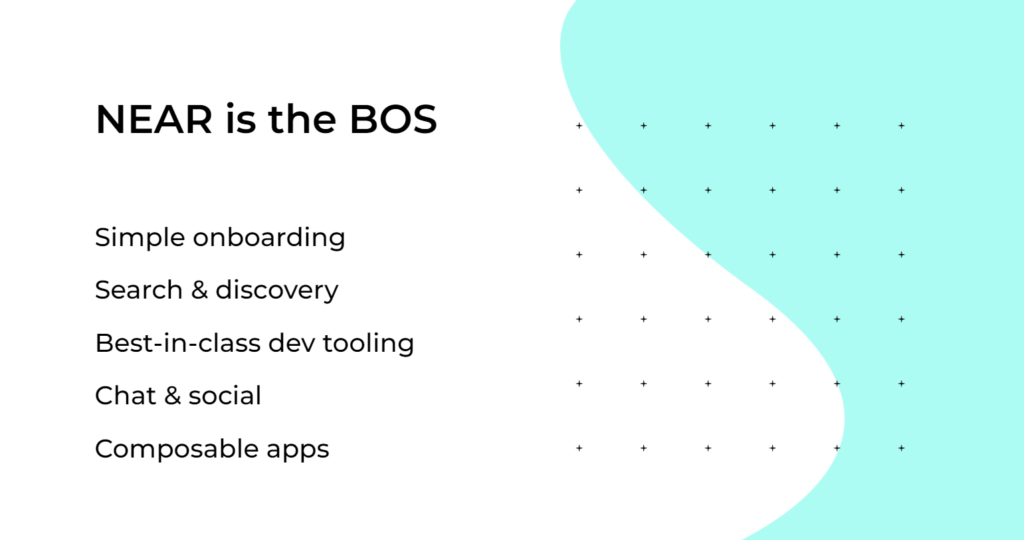
Since inception, Near’s mission has been to onboard 1 billion users to the Open Web. The first step in the journey was to focus on building a best in class L1 blockchain that was easy to build on and easy to use.
Near was designed to be simple, with a flexible account model and human readable accounts — any name a user wants instead of a string of letters and numbers. And with Near’s Nightshade sharding approach, the Near blockchain was designed to be infinitely scalable and secure. At the same time, Near concentrated on building out tooling to support builders developing on the protocol, including the JavaScript SDK that now gives 15 million developers access to building on Near.
This has created and sustained a thriving Near ecosystem with more than 23 million accounts and over a thousand project building, but these were only the first steps toward delivering the vision of Web3 to a mainstream audience.
Now, Near is building up the Web3 stack to integrate experiences from across the open web and streamline the discovery and onboarding experience for users and developers alike.
Enter Near: the Blockchain Operating System
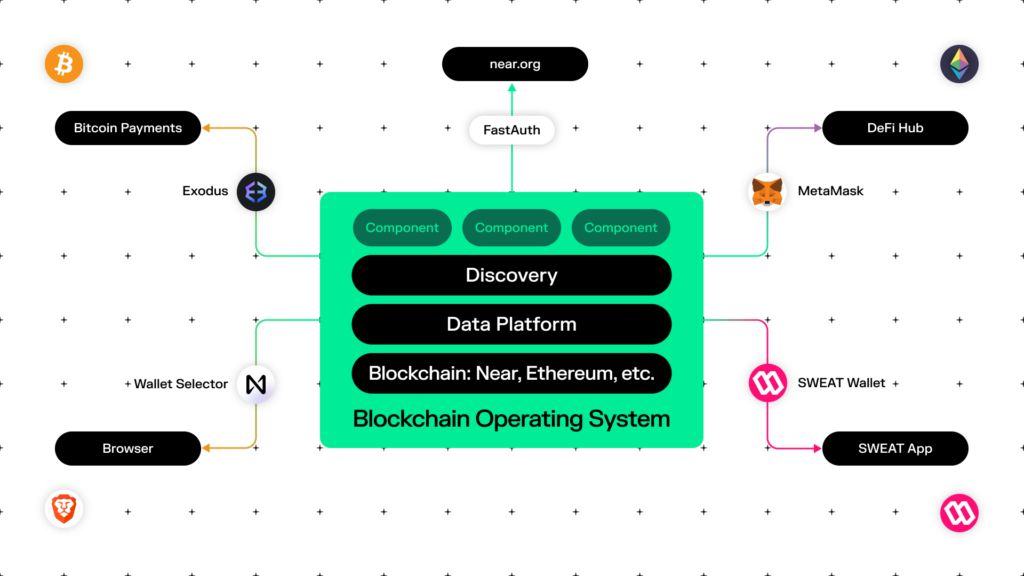
Today, Near is launching near.org — a composable frontend for Web3. It will allow end users to easily and frictionlessly discover all of Web3’s possibilities in one seamless experience. It will also empower developers to create and code interfaces in a single environment with the ability to fork a host of components to build apps faster, and more efficiently than ever before.
Anyone in the Open Web ecosystem can create their own frontends (i.e., their own versions of near.org), compatible with the blockchain of their choice. This means that builders from any ecosystem can create components in just a few lines of code, and take advantage of fast onboarding to help make new and custom Web3 experiences.
This is an industry first. With the addition of composable frontends to the tech stack, Near now becomes the Blockchain Operating System, allowing seamless, one-time onboarding and removing friction points like making accounts for every experience, while supercharging development from a collection of over 1,800 components.
Near.org is the first step in Near’s Blockchain Operating System journey. It’s the Alpha version, where builders can see the frontend come to life.
Try it out at near.org to experience the world’s first Blockchain Operating System — a revolutionary moment in Web3. If you’re a developer, see how easy it is to fork components and create new experiences. If you’re an end user, see how easy it is to explore Web3 experiences, social, and news all in one place.
The Blockchain Operating System is Near and it’s here. #NearistheBOS
The post Near Announces the Blockchain Operating System appeared first on NEAR Protocol.
]]>